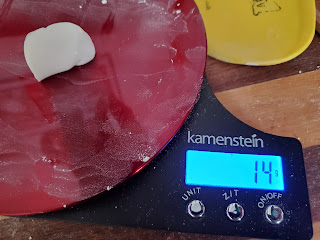Did you notice in most of the ingredients in pre-packaged Japanese food contain Corn Syrups, Heavy Sugar Syrups, syrups, syrups... OMG. I wish someone would tell them to stop it.
Anyways, until that is changed, I have to make my own.
Instead of eating an empty carb, I thought why not mix some ground flaxseed mill and matcha. So, I did. The result is Delicious!
To the basics MITARASH DANGO recipes, I added 1 TBsp of Organic MATCHA and 2 TBsp of Ground Flaxseed Mill. Add enough water and Knead the dough till earlobe smooth.
Basic ingredients: https://rockdavinci.blogspot.com/search?q=MITARASHI+DANGO
Use a 1 inch cookie dough scooper to make even numbers of balls, then, roll them into ball between palms of your hand.
Bring a pot of water to a full rolling boil. Drop rolled DANGO without letting them touch each other. Quickly stir them off the bottom to prevent them from sticking to the bottom of the pot.
Stir and loosen from the bottom of the pot.
Bring a pot of water to a full rolling boil. Drop rolled DANGO without letting them touch each other. Quickly stir them off the bottom to prevent them from sticking to the bottom of the pot.
Stir and loosen from the bottom of the pot.
Wait for the water to return to full boil.
Boil 2 minutes to come to rolling boil. DANGO should float to surface as they are cooked.Boil 3 to 4 minutes longer depending on the original size of your rolled DANGO. Take one out and cut, if you are not sure. If the entire DANGO is translucent, it is ready. If you see any milky center, the rolled dough is still raw. Cook longer. The DANGO should / maybe double in size by now.
Transfer to a strainer. Separate them and do not let them stick to each other.
Moisten your hand and skewer them onto Japanese Teppo Gushi - bamboo skewers. It can be found at Amazon or DAISO. https://www.amazon.com/JapanBargain-1598x8-J-1598x8-Bamboo-Style-7/dp/B00OJVM54U Normally three DANGO to a stick.
If you are going to make YAKI MITARE DANGO, be sure to place bamboo skewers in water for 30 minutes before placing skewered DANGO over the grill. The other way is just place DANGO in a skillet with ceramic surface, for example, and bake one side brown is an idea.
Roll the skewered DANGO with MITARE (syrup). Enjoy!
Ready to make the MITARE SYRUP. At the last minutes, I found out that I ran out of the KATAKURIKO - Potato starch. So I used corn starch, knowing that the result would be different. As you can tell from the photo, whether I cook it for 10 minutes or 20 minutes, the corn start MITARE will look muddy, not translucent.
MITARE (sweet syrup for the DANGO) Double the batch if more Dango is made.
Sugar 100 g
Soy sauce 50 ml
MIRIN 30 ml (Japanese cooking wine)
Water 180 ml - separate 150 ml and 30 ml to mix with potato starch
Potato starch - KATAKURIKO 20 g to 25 g (*or more - test it - DO NOT use CORN starch; arrow root starch is okay.)
Sugar 100 g
Soy sauce 50 ml
MIRIN 30 ml (Japanese cooking wine)
Water 180 ml - separate 150 ml and 30 ml to mix with potato starch
Potato starch - KATAKURIKO 20 g to 25 g (*or more - test it - DO NOT use CORN starch; arrow root starch is okay.)
The syrup should become shiny and translucent, but with corn starch, it is as good as it can get in this case, but the syrup should be thick enough to cover the air dried boiled DANGO.

































































